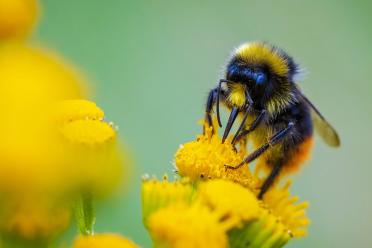
Scientists from the Earlham Institute, Imperial College London, Natural History Museum, London, and other partners have analysed UK bumblebee populations to understand how they have responded to changing environmental pressures.
In the first of two papers, researchers investigated the body shapes, or morphology, of bee specimens dating back to 1900. Using digital images, the group first investigated the asymmetry in bumblebee wings as an indicator of stress.
High asymmetry - very differently shaped right and left wings - indicates the bees experienced stress during development from an external factor that affected their normal growth.
Studying four UK bumblebee species, the group found evidence for stress getting higher as the century progressed from its lowest point around 1925. Further analysis showed that each bee species displayed a consistently higher proxy of stress in the latter half of the century.
By taking the climate conditions during the year of collection – namely annual mean temperature and annual rainfall – the team found that in hotter and wetter years bees showed higher wing asymmetry. This first paper, which doesn’t include authors from the Earlham Institute, is published today in the Journal of Animal Ecology.
Senior author Dr Richard Gill, from the Department of Life Sciences (Silwood Park) at Imperial, said: “With hotter and wetter conditions predicted to place bumblebees under higher stress, the fact these conditions will become more frequent under climate change means bumblebees may be in for a rough time over the 21st century.”
As well as measuring the wing shapes of bees, the team successfully sequenced the genomes of over a hundred bumblebee museum specimens dating back more than 130 years in a second parallel study.
In a pioneering advance, ancient DNA methods typically used for studying woolly mammoths and ancient humans were for the first time used on an insect population.
Scientists from the Natural History Museum and the Earlham Institute quantified DNA preservation using just a single bee leg from each of the bees studied. From these developments, published today in Methods in Ecology & Evolution, the researchers can now look to determine how the reported stress may lead to genetic diversity loss.
Dr Will Nash, Postdoctoral Researcher in the Haerty Group at the Earlham Institute and study author, said: “Bee populations have been in a worrying decline, which is bad news for biodiversity and food security. Understanding and predicting stressors can help us to better protect these populations and take action to boost their numbers.
“Thanks to the infrastructure and expertise at the Earlham Institute, particularly the Genomics Pipelines team, we’ve been able to develop novel approaches to extracting and sequencing DNA from individual insects. This opens up exciting possibilities for a range of future studies looking at how genomes change over time and respond to different pressures.”
In conjunction with providing a new reference genome, the team will now use this data to study how bee genomes have changed over time, gaining an understanding of how whole populations have adapted – or not – to changing environments.
Focusing on bumblebee collections, the team worked with curators from the Natural History Museum London, National Museums Scotland, Oxford University Museum of Natural History, World Museum Liverpool, and Tullie House Museum Carlisle.
Dr Wilfried Haerty, author and Group Leader at the Earlham Institute, said: “Museum specimens represent an exciting untapped source of genetic information, which can help us identify and explain the historic changes taking place in the genome of a species.
“Thanks to the development of a new variation on the PacBio Hifi sequencing method, we’ve been able to allow single insects to be sequenced from very tiny amounts of DNA. With the Earlham Institute providing a reference genome and the Natural History Museum adding its expertise in ancient DNA, we’ve been able to help build a timeline of the bee genome over the last century that can then be compared to corresponding data about the climate during this period.”
Dr Gill concluded: “These studies showcase the value of leveraging museums’ specimens to go back in time and unlock the past’s secrets. But what we have done is just the beginning, and by continuing our work with these vital public collections and collaborating with curators we can only discover more.
“This work was part of a Natural Environment Research Council-funded project and could not have been achieved without the commitment, hard work, and diligence of the museum curators, and our other collaborators. We are also grateful to BBSRC funds in supporting the generation of the bumblebee reference genome.”




